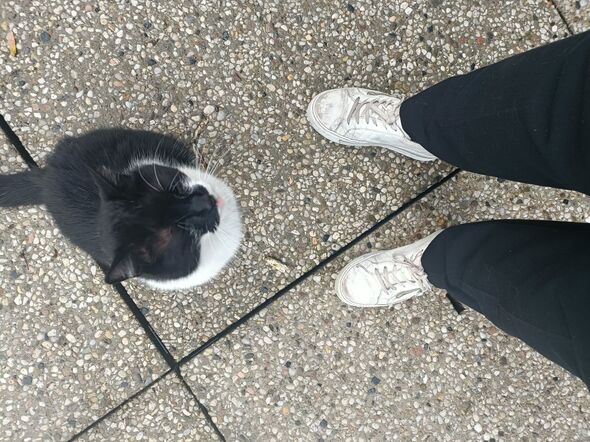Who takes care of the campus cats?
Anyone who’s in the vicinity of Spar now and then will have spotted them: the campus cats. The faithful four-legged friends can regularly be found outside the supermarket or in the adjacent Luna building. They don’t have a designated caretaker; students and staff care for them together.
At the moment, there are at least two cats on campus. One (name unknown) has orange fur and prefers to sit outside Spar, as evidenced by its chunky physique. The other one, black and white (header), is called Luna and can regularly be found in the eponymous Luna building. She’s often lounging on one of the benches on the first floor.
According to Anneke Michielsen at the Facility Management Center, Luna (if that’s her real name) is probably not a stray cat, but belongs to someone in the neighborhood. According to Anneke, Luna comes by every day, because she’s fond of the attention (or is it the food?). A third cat, a calico, is also rumored to roam the campus, but hasn’t been spotted for a while now.
Fish for lunch
The cats don’t have a designated caretaker; members of the TU/e community care for them together. Especially people involved in building management, facility officers, make sure the cats don’t go hungry or thirsty. They might be given a bowl of water, a fish left over from lunch, or simply some dry cat food. And they of course get plenty of attention throughout the day from all the students on campus, who are more than happy to give the cats a cuddle or a treat.
With all that attention and food, it’s not surprising the cats can often be found close to the supermarket. Cindy Rakhorst-Hamers of the ROZE regional shelter for stray animals: “If the cats themselves ask for attention, that’s obviously fine. Feeding them isn’t a problem either. It’s nice to see cats looked after.” Having said that, students do need to be careful about what they give the cats. “Try to give cat food rather than human food. And with the warm weather we’re having, a bowl of water is also very nice.”
Catching initiative
In 2019, there were more than twenty cats on campus, a catching initiative by animal protection revealed at the time. At the request of the university, the feral cats were caught, neutered or spayed, and released again. This was necessary, because otherwise the number of stray cats would become too high.
In 2022, ROZE took over the responsibility for the catching initiatives from animal protection. “Since then, we’ve received the occasional report on sick or wounded cats. Those we try to capture and treat,” says Cindy Rakhorst-Hamers, who also coordinators the initiatives known as Trap, Neuter, Return (TNR).
Out of those twenty cats in 2010, at least two are left. According to Rakhorst-Hamers, this shows the catching initiatives worked. “Once all cats had been neutralized, no new kittens were born. In addition, the neutralized cats fend off others trying to enter their habitat. This slowly thins the population. As we do this at the regional level, these initiatives work very well.”
Cursor is looking for pictures of the campus cats. If you snapped a great one of our four-legged friends, please email it to cursor@tue.nl
![[Translate to English:]](/fileadmin/_processed_/2/6/csm_Katten_hoofd_%40ElsVanRooij_dbf61ad715.jpg)




Discussion